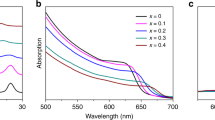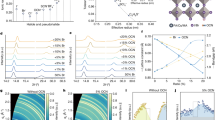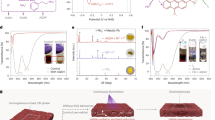Abstract
Mixed halide wide-bandgap perovskites are suitable for integration in tandem photovoltaics such as perovskite/organic tandem solar cells. However, halide phase segregation originating from halogen vacancy-assisted ion migration in wide-bandgap perovskites limits the device efficiency and lifetime. Here we incorporate pseudo-halogen thiocyanate (SCN) ions in iodide/bromide mixed halide perovskites and show that they enhance crystallization and reduce grain boundaries. Trace amount of SCN ions in the bulk enter the perovskite lattice, forming an I/Br/SCN alloy, and occupy iodine vacancies, blocking halide ion migration via steric hindrance. Taken together, these effects retard halide phase segregation under operation and reduce energy loss in the wide-bandgap perovskite cells. The resulting perovskite/organic tandem solar cell achieves a power conversion efficiency of 25.82% (certified 25.06%) and an operational stability of 1,000 h.
This is a preview of subscription content, access via your institution
Access options
Access Nature and 54 other Nature Portfolio journals
Get Nature+, our best-value online-access subscription
$29.99 / 30 days
cancel any time
Subscribe to this journal
Receive 12 digital issues and online access to articles
$119.00 per year
only $9.92 per issue
Buy this article
- Purchase on Springer Link
- Instant access to full article PDF
Prices may be subject to local taxes which are calculated during checkout




Similar content being viewed by others
Data availability
The authors declare that the experimental data that support the findings of this paper are available within this article and its Supplementary Information files. Other findings in this study are available from the corresponding authors on reasonable request. Source data are provided with this paper.
References
Chen, T. et al. Compromising charge generation and recombination of organic photovoltaics with mixed diluents strategy for certified 19.4% efficiency. Adv. Mater. 35, 2300400 (2023).
Lin, H. et al. Silicon heterojunction solar cells with up to 26.81% efficiency achieved by electrically optimized nanocrystalline-silicon hole contact layers. Nat. Energy 8, 789–799 (2023).
Chen, W. et al. A semitransparent inorganic perovskite film for overcoming ultraviolet light instability of organic solar cells and achieving 14.03% efficiency. Adv. Mater. 30, 1800855 (2018).
Brinkmann, K. O. et al. Perovskite/organic tandem solar cells with indium oxide interconnect. Nature 604, 280–286 (2022).
Chen, W. et al. Monolithic perovskite/organic tandem solar cells with 23.6% efficiency enabled by reduced voltage losses and optimized interconnecting layer. Nat. Energy 7, 229–237 (2022).
Yang, H. et al. Regulating charge carrier recombination in the interconnecting layer to boost the efficiency and stability of monolithic perovskite/organic tandem solar cells. Adv. Mater. 35, 2208604 (2023).
Wang, X. et al. Highly efficient perovskite/organic tandem solar cells enabled by mixed-cation surface modulation. Adv. Mater. 35, 2305946 (2023).
An, Y. et al. Optimizing crystallization in wide-bandgap mixed halide perovskites for high-efficiency solar cells. Adv. Mater. https://doi.org/10.1002/adma.202306568 (2023).
Ma, Z. et al. Transparent recombination electrode with dual-functional transport and protective layer for efficient and stable monolithic perovskite/organic tandem solar cells. Adv. Mater. 35, 2307502 (2023).
Abdi-Jalebi, M. et al. Maximizing and stabilizing luminescence from halide perovskites with potassium passivation. Nature 555, 497–501 (2018).
Yang, G. et al. Defect engineering in wide-bandgap perovskites for efficient perovskite-silicon tandem solar cells. Nat. Photon. 16, 588–594 (2022).
Wang, S. et al. Inorganic perovskite surface reconfiguration for stable inverted solar cell with 20.38% efficiency and its application in tandem devices. Adv. Mater. 35, 2300581 (2023).
Tao, L. et al. Stabilizing wide-bandgap halide perovskites through hydrogen bonding. Sci. China Chem. 65, 1650–1660 (2022).
Zhao, Y. et al. A bilayer conducting polymer structure for planar perovskite solar cells with over 1,400 hours operational stability at elevated temperatures. Nat. Energy 7, 144–152 (2022).
Wang, J. et al. Halide homogenization for low energy loss in 2-eV-bandgap perovskites and increased efficiency in all-perovskite triple-junction solar cells. Nat. Energy 9, 70–80 (2024).
Kim, T. et al. Mapping the pathways of photo-induced ion migration in organic–inorganic hybrid halide perovskites. Nat. Commun. 14, 1846 (2023).
Zhan, Y. et al. Elastic lattice and excess charge carrier manipulation in 1D–3D perovskite solar cells for exceptionally long-term operational stability. Adv. Mater. 33, 2105170 (2021).
Yuan, Y. & Huang, J. Ion migration in organometal trihalide perovskite and its impact on photovoltaic efficiency and stability. Acc. Chem. Res. 49, 286–293 (2016).
Kerner, R. A. & Rand, B. P. Linking chemistry at the TiO2/CH3NH3PbI3 interface to current–voltage hysteresis. J. Phys. Chem. Lett. 8, 2298–2303 (2017).
Zhu, W. et al. Ion migration in organic–inorganic hybrid perovskite solar cells: current understanding and perspectives. Small 18, 2105783 (2022).
Draguta, S. et al. Rationalizing the light-induced phase separation of mixed halide organic-inorganic perovskites. Nat. Commun. 8, 200 (2017).
Chen, Z., Brocks, G., Tao, S. & Bobbert, P. A. Unified theory for light-induced halide segregation in mixed halide perovskites. Nat. Commun. 12, 2687 (2021).
Xu, J. et al. Triple-halide wide-bandgap perovskites with suppressed phase segregation for efficient tandems. Science 367, 1097–1104 (2020).
Stoddard, R. J. et al. Enhancing defect tolerance and phase stability of high-bandgap perovskites via guanidinium alloying. ACS Energy Lett. 3, 1261–1268 (2018).
Wang, C. et al. Suppressing phase segregation in wide-bandgap perovskites for monolithic perovskite/organic tandem solar cells with reduced voltage loss. Small 18, 2204081 (2022).
Grater, L. et al. Sterically suppressed phase segregation in 3D hollow mixed halide wide-bandgap perovskites. J. Phys. Chem. Lett. 14, 6157–6162 (2023).
Ruth, A. et al. Vacancy-mediated anion photosegregation kinetics in mixed halide hybrid perovskites: coupled kinetic Monte Carlo and optical measurements. ACS Energy Lett. 3, 2321–2328 (2018).
Liu, H. et al. Suppressing the photoinduced halide segregation in wide-bandgap perovskite solar cells by strain relaxation. Adv. Funct. Mater. 33, 2303673 (2023).
Luo, X. et al. Progress of all-perovskite tandem solar cells: the role of narrow-bandgap absorbers. Sci. China Chem. 64, 218–227 (2021).
Chen, W. et al. Surface reconstruction for stable monolithic all-inorganic perovskite/organic tandem solar cells with over 21% efficiency. Adv. Funct. Mater. 32, 2109321 (2022).
Lin, P.-Y. et al. Revealing the role of thiocyanate for improving the performance of perovskite solar cells. ACS Appl. Energy Mater. 6, 79–88 (2023).
Zhao, Y. et al. Suppressing ion migration in metal halide perovskite via interstitial doping with a trace amount of multivalent cations. Nat. Mater. 21, 1396–1402 (2022).
Chen, H. et al. Regulating surface potential maximizes voltage in all-perovskite tandems. Nature 613, 676–681 (2023).
Wei, L. et al. Phase segregation enhanced ion movement in efficient inorganic CsPbIBr2 solar cells. Adv. Energy Mater. 7, 1700946 (2017).
Wen, J. et al. Steric engineering enables efficient and photostable wide-bandgap perovskites for all-perovskite tandem solar cells. Adv. Mater. 34, 2110356 (2022).
Rau, U. Reciprocity relation between photovoltaic quantum efficiency and electroluminescent emission of solar cells. Phys. Rev. B 76, 085303 (2007).
Lin, R. et al. All-perovskite tandem solar cells with 3D/3D bilayer perovskite heterojunction. Nature 620, 994–1000 (2023).
Kirchartz, T., Rau, U., Kurth, M., Mattheis, J. & Werner, J.H. Comparative study of electroluminescence from Cu(InGa)Se2 and Si solar cells. Thin Solid Films 515, 6238–6242 (2007).
Zeng, Q. et al. A two-terminal all-inorganic perovskite/organic tandem solar cell. Sci. Bull. 64, 885–887 (2019).
Chen, X. et al. Efficient and reproducible monolithic perovskite/organic tandem solar cells with low-loss interconnecting layers. Joule 4, 1594–1606 (2020).
Wang, P. et al. Tuning of the interconnecting layer for monolithic perovskite/organic tandem solar cells with record efficiency exceeding 21%. Nano Lett. 21, 7845–7854 (2021).
Acknowledgements
This work was supported by the National Natural Science Foundation of China (grant nos. 52325307, 22075194, 52203233, 52273188 and 52102287), the National Key Research and Development Program of China (grant no. 2022YFB4200302 and 2020YFB1506400), Department of Science and Technology of Jiangsu Province (grant no. BE2022023), the National Postdoctoral Program for Innovative Talents (grant no. BX2021205), project funded by China Postdoctoral Science Foundation (grant no. 2022M710102), the Priority Academic Program Development of Jiangsu Higher Education Institutions (PAPD), Collaborative Innovation Center of Suzhou Nano Science and Technology, and the Key Laboratory of Polymeric Materials Design and Synthesis for Biomedical Function, Soochow University.
Author information
Authors and Affiliations
Contributions
W.C., C.J.B. and Yaowen Li conceived the project. Z.Z. and J.C. made the devices and contributed to the performance improvement. X.J. conducted the DFT calculation. Y.S. conducted the GIWAXS measurement and performed the results analysis. Z.Z. and Heyi Yang analysed the MPP stability and impedance spectra. Q.C. measured the absorption spectra and performed the results analysis. Z.Z. and X.C. measured the in situ absorption spectra and PL spectra. S.K. measured the XRD spectra. X.T. encapsulated the devices for certification. H.C., F.Y., Haidi Yang and X.-m.O. participated in the characterizations of devices. Z.Z., W.C., C.J.B., Yaowen Li and Yongfang Li contributed to the results analysis. W.C. and Yaowen Li wrote the paper. W.C., C.J.B., Yaowen Li and Yongfang Li supervised the project. All authors discussed the results and commented on the final paper.
Corresponding authors
Ethics declarations
Competing interests
The authors declare no competing interests.
Peer review
Peer review information
Nature Energy thanks Peter Chen, Byungha Shin and Zonglong Zhu for their contribution to the peer review of this work.
Additional information
Publisher’s note Springer Nature remains neutral with regard to jurisdictional claims in published maps and institutional affiliations.
Supplementary information
Supplementary Information
Supplementary Notes 1–12, Figs. 1–45 and Tables 1–10.
Source data
Source Data Fig. 1
Statistical source data.
Source Data Fig. 2
Statistical source data.
Source Data Fig. 3
Statistical source data.
Source Data Fig. 4
Statistical source data.
Rights and permissions
Springer Nature or its licensor (e.g. a society or other partner) holds exclusive rights to this article under a publishing agreement with the author(s) or other rightsholder(s); author self-archiving of the accepted manuscript version of this article is solely governed by the terms of such publishing agreement and applicable law.
About this article
Cite this article
Zhang, Z., Chen, W., Jiang, X. et al. Suppression of phase segregation in wide-bandgap perovskites with thiocyanate ions for perovskite/organic tandems with 25.06% efficiency. Nat Energy (2024). https://doi.org/10.1038/s41560-024-01491-0
Received:
Accepted:
Published:
DOI: https://doi.org/10.1038/s41560-024-01491-0



